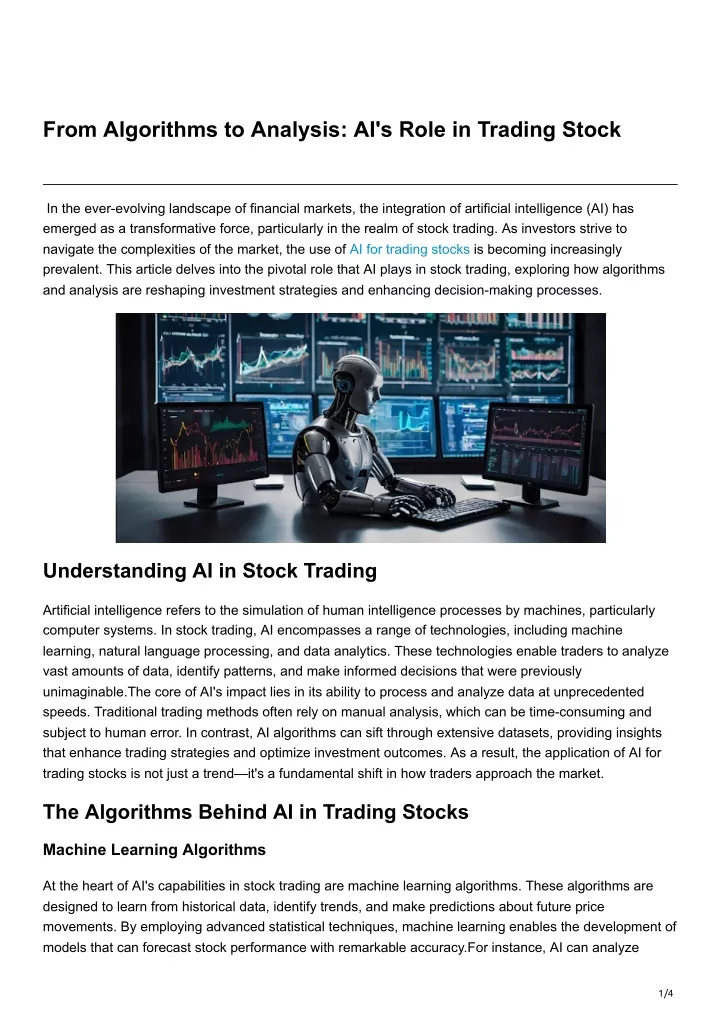20 Excellent Ideas For Choosing AI Stock Investing Analysis Websites
20 Excellent Ideas For Choosing AI Stock Investing Analysis Websites
Blog Article
Top 10 Tips On Assessing The Accuracy And Performance Of Ai Stock Predicting/Analyzing Trading Platforms
You need to check the accuracy of AI trading platforms that forecast and analyze prices of stocks. This will help ensure that you're using a reliable tool. These are the top 10 suggestions to assess these platforms efficiently:
1. Backtesting Results
What to be looking for: Ensure the platform you choose to use allows users to run back-tests in order to see how accurate its predictions were based on the past data.
Why It Matters : Backtesting is a way to test an AI model by comparing its predictions against historical results.
Tip: Look for platforms that allow you to modify the parameters of backtesting (e.g. the time period or asset classes).
2. Real-time Performance Tracking
What to look out for What the platform does during real-time conditions.
Why it matters Real-time performance provides a much better gauge of its efficiency instead of relying solely on past backtesting.
TIP: Watch live forecasts in real time and compare them to market developments by using a demo or a trial for free.
3. Prediction Error Metrics
What to Watch Out For To measure the accuracy of prediction, try evaluating metrics like the Mean Absolute Error(MAE) or the Root-Mean Squared Error(RMSE) or Rsquared.
What is the significance of these metrics provide a quantitative measure of how accurate the forecasts are actual results.
Tip: Platforms which openly provide these metrics are typically more transparent and trustworthy.
4. The rate of winning and the success ratio
What to look for Look for the platform's win rate (percentage of correct predictions) and the success rate (profitability of trading that are based on forecasts).
What is important: High success rates and win percentages indicate greater accuracy in predicting the future and a higher chance of generating profits.
You should be wary of websites that claim to have a high success rate (e.g. 90%) %+),) as the system cannot guarantee 100 percent success.
5. Benchmarking Market Indices for Benchmarking
What to look out for: Compare performance and predictions of the platform with major market indices.
Why it is Important: This helps determine if the platform outperforms or underperforms the broader market.
Find consistency in performance, not just gains over a short amount of time.
6. Consistency across Market Conditions
What to look out for: Examine how the platform's performance is affected by different market conditions.
What is important The platform that is robust must be able to perform in all market conditions, not just when the market is favorable.
Tip: Test the platform's predictions in volatile market conditions or periods that are low in volatility.
7. Transparency in Methodology
What to look out for What to Look Out For: Learn about AI models algorithms, techniques, and models (e.g., neural network, reinforcement learning).
Why it is Important Transparency in the methodology can help to assess the credibility and scientific integrity of the platform.
Avoid platforms using "black box models" that don't clarify how predictions can be generated.
8. Independent testing and User Reviews
What to look out for: Read reviews from users and check for independent testing.
Why It Matters: Independent reviews and testing provide unbiased insights into the platform's accuracy and performance.
Visit forums such as Reddit or copyright to read what others have said.
9. Risk-Adjusted Returns
What to look out for: Use risk-adjusted metrics, such as the Sharpe Ratio (or Sortino Ratio), to gauge the performance of the platform.
What is important What are these metrics? They reflect the amount of risk required in order to make returns, and provide more complete information about the performance.
Sharpe Ratio: If it's high (e.g. > 1) This indicates higher returns when risk is taken into account.
10. Long-Term Track Record
What to Look For How to evaluate the performance of the platform over a time period (e.g. 3-5 years).
Why it matters The long-term track record is an accurate indicator over short-term outcomes.
TIP: Avoid platforms that focus on quick-term successes or results that are cherry-picked.
Bonus Tip: Try it with a Demo Account
Test the platform's real-time predictions with a trial or demo account, without having to risk your money. This allows you to evaluate accuracy and performance.
Follow these tips to thoroughly assess the accuracy, efficiency, and reliability of AI stock prediction and analysis platforms. It is then possible to select the one that is most compatible with your goals for trading, and your ability to take risks. Remember that no system is perfect. Combining AI insights with your research is the best way to go. Check out the top best ai stock for website examples including investing ai, chatgpt copyright, ai trade, chatgpt copyright, ai stock market, ai stock trading bot free, best ai trading software, ai stocks, ai stock trading bot free, best ai trading software and more.
Top 10 Tips On Assessing The Risk Management Of Ai Stock Prediction And Analysis Of Trading Platforms
Risk management is a crucial element of any AI trading platform for predicting or analyzing stocks that helps safeguard your investment and limit potential losses. Platforms with strong risk management tools can assist you in navigating turbulent stock markets and make an decisions based on information. Here are the top 10 tips to evaluate the risk management capabilities of these platforms:
1. Review of Take-Profit and Stop-Loss Features
Configurable settings: Ensure that you have the ability to set the maximum take-profit and stop-loss levels for certain trades.
Make sure that your trading platform supports trailing stop which automatically adjusts in the event that the market moves toward your.
You must determine if there are any stop-loss options that can assure that your position will be closed at the agreed rate, even if markets are volatile.
2. Calculate Position Size Tools
Fixed amount - Make sure that you know the amount of your positions according to a set amount.
Percentage in your portfolio Manage your risk by determining positions sizes in proportion to a percentage.
Risk-reward Ratio: Ensure that the platform allows for setting individual risk-reward levels.
3. Make sure you check for support for Diversification.
Multi-asset trading: Make sure the platform you choose to use allows you to trade across different types of assets, including stocks, ETFs and options. This can help you diversify your portfolio.
Sector allocation: Verify whether the platform provides tools to monitor and manage sector exposure.
Diversification of the geographic area. Examine whether your platform permits you to trade on international markets. This can help spread the geographic risk.
4. Review margin and leverage controls
Margin requirements: Ensure the platform clearly outlines any limitations on margins when trading leveraged.
Limits on leverage: See whether the platform allows you to set leverage limits to manage the risk exposure.
Margin calls: Check if you are receiving prompt notifications from the platform in order to avoid account liquidation.
5. Assessment Risk Analytics and reporting
Risk metrics: Ensure the platform provides key risk metrics (e.g. Value at Risk (VaR), Sharpe ratio drawdown, Sharpe ratio) for your portfolio.
Scenario analysis: Find out whether the platform allows you to model different market scenarios to assess possible risks.
Performance reports: Verify whether the platform has complete performance reports, including risk-adjusted returns.
6. Check for Real-Time Risk Monitoring
Portfolio monitoring: Make sure that the platform offers real-time monitoring of your portfolio's risk exposure.
Alerts and notifications. Verify whether the platform can provide real-time notification of risk-related events.
Risk dashboards: Make sure the platform provides an adjustable risk dashboard that gives you a full picture of your personal profile.
7. How to evaluate the results of Stress Testing and Backtesting
Stress testing: Make sure the platform lets you stress test your strategies or portfolio in extreme market conditions.
Backtesting - Check to see if your platform allows you to backtest your strategies using historical information. This is an excellent way to assess the risks and determine the performance.
Monte Carlo: Verify the platform's use of Monte Carlo-based simulations to evaluate risk and modeling a range of possible outcomes.
8. Verify Compliance with Risk Management Regulations
Make sure that the platform is in compliance with the regulatory compliance requirements (e.g. MiFID II regulations in Europe, Reg T regulations in the U.S.).
Best execution: Ensure that the platform follows best execution practices. It will guarantee that transactions are completed to the most competitive price to avoid loss.
Transparency. Verify that the platform is transparent and clear about the risks.
9. Examine the User-Controlled Risk Parameters
Custom risk rules - Make sure the platform allows for you to define your own risk management guidelines.
Automated controls for risk: Check to see whether your platform is able to implement risk management policies automatically on parameters you have defined.
Manual overrides - Check to see if your platform lets you manually override automated risk controls.
Study Case Studies, User Feedback, and Case Studies
User feedback: Use user reviews to determine the platform's capacity to take care of risk.
Case studies: Seek out case studies or testimonials highlighting the risk management capabilities of the platform.
Community forums: Find out whether the platform hosts an active user community in which traders discuss risk management tips and strategies.
Bonus Tips:
Trial period: Use the demo or trial version for free to test the features of the platform for risk management in real-world scenarios.
Customer support: Make sure the platform provides robust support to any questions or issues that are related to the management of risk.
Check for educational resources.
With these suggestions, you can assess the ability of AI platforms for stock prediction and analysis to manage the risk. This will help you choose a platform that safeguards your investment and reduces the possibility of losses. To stay out of volatile markets and achieve long-term success in trading you require a reliable risk management software. Take a look at the top rated sources tell me for ai stock investing for site tips including ai trading tool, ai stock price prediction, ai share trading, ai copyright signals, stocks ai, ai software stocks, stock predictor, ai software stocks, can ai predict stock market, can ai predict stock market and more.